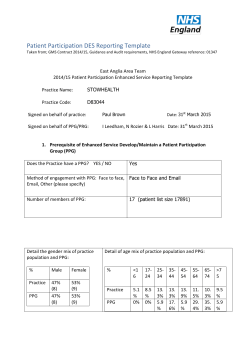
Introduction to Cryptology
Introduction to Cryptology
Lecture 9
Announcements
• HW4 up, due on Tuesday, 3/3
• If you did not receive a grade for HW2 (but
handed it in) please see TA
• Substitute on 3/5 (Dr. Feng-Hao Liu)
• Upcoming: Midterm in class on 3/12
– Review problems and review session
– Details coming soon
Agenda
• Last time:
– Construction of SKE from PRG (3.3)
– Security Analysis of Scheme (3.3)
• This time:
– CPA security (3.4)
– Construction of CPA-secure SKE from PRF (3.5)
– Modes of Operation (3.6)
PRG Example
Similar to Homework Problems
Let 𝐺 be a pseudorandom generator with
expansion factor ℓ 𝑛 > 2𝑛.
Is 𝐺 ′ 𝑠 = 𝐺(𝑠| 𝑠 a pseudorandom generator?
Answer: No.
Intuition: Although 𝑠 is uniformly distributed,
(𝑠| 𝑠 is not. Guarantees for PRG hold only
when the seed is selected uniformly at random.
PRG Example
Similar to Homework Problems
Let 𝐺 be a pseudorandom generator with expansion
factor ℓ 𝑛 > 2𝑛.
Is 𝐺 ′ 𝑠 = 𝐺(𝑠| 𝑠 a pseudorandom generator?
Answer: No.
To get full credit, must give a counterexample.
1. Define 𝐺 in terms of another PRG 𝐺 ∗
2. Show that 𝐺 is a secure PRG
3. Show that 𝐺′ is insecure by presenting a
distinguisher.
PRG Example
Similar to Homework Problems
1. Define 𝐺 in terms of another PRG 𝐺 ∗
𝐺 𝑠 = 𝐺(𝑠1 | 𝑠2 = 𝐺 ∗ (𝑠1 ⊕ 𝑠2 )
(assume 𝐺 ∗ has expansion factor ℓ 𝑛 > 4𝑛.
2. Show that 𝐺 is a secure PRG
– Intuition: If 𝑠 = 𝑠1 ||𝑠2 is uniformly distributed, then
so is 𝑠1 ⊕ 𝑠2
3. Show that 𝐺′ is insecure by presenting a
distinguisher.
– Distinguisher 𝐷(w) outputs 1 if 𝑤 = 𝐺 ∗ (0𝑛/2 )
– Otherwise, output 0.
PRG Example
Similar to Homework Problems
Pr 𝐷 𝐺 ′ 𝑠 = 1 − Pr 𝐷 𝑟 = 1 =
Pr[𝐷 𝐺 𝑠 𝑠 = 1 − Pr[𝐷 𝑟 = 1] =
Pr[𝐷 𝐺 ∗ (𝑠 ⊕ 𝑠)) = 1 − Pr[𝐷 𝑟 = 1] =
Pr[𝐷 𝐺 ∗ (0𝑛/2 )) = 1 − Pr[𝐷 𝑟 = 1] =
1 − Pr[𝑟 = 𝐺 ∗ (0𝑛/2 )] =
1
1 − ℓ(𝑛)
2
This is non-negligible and so 𝐷 is indeed a distinguisher.
New Material
CPA-Security
The CPA Indistinguishability Experiment 𝑃𝑟𝑖𝑣𝐾 𝑐𝑝𝑎 𝐴,Π 𝑛 :
1. A key 𝑘 is generated by running 𝐺𝑒𝑛 1𝑛 .
2. The adversary 𝐴 is given input 1𝑛 and oracle access to
𝐸𝑛𝑐𝑘 ⋅ , and outputs a pair of messages 𝑚0 , 𝑚1 of the same
length.
3. A random bit 𝑏 ← {0,1} is chosen, and then a challenge
ciphertext 𝑐 ← 𝐸𝑛𝑐𝑘 𝑚𝑏 is computed and given to 𝐴.
4. The adversary 𝐴 continues to have oracle access to 𝐸𝑛𝑐𝑘 ⋅ ,
and outputs a bit 𝑏′.
5. The output of the experiment is defined to be 1 if 𝑏 ′ = 𝑏,
and 0 otherwise.
CPA-Security
Definition: A private-key encryption scheme
Π = 𝐺𝑒𝑛, 𝐸𝑛𝑐, 𝐷𝑒𝑐 has indistinguishable
encryptions under a chosen-plaintext attack if for all
ppt adversaries 𝐴 there exists a negligible function
𝑛𝑒𝑔𝑙 such that
1
𝑐𝑝𝑎
Pr 𝑃𝑟𝑖𝑣𝐾 𝐴,Π 𝑛 = 1 ≤ + 𝑛𝑒𝑔𝑙 𝑛 ,
2
where the probability is taken over the random
coins used by 𝐴, as well as the random coins used in
the experiment.
CPA-security for multiple encryptions
Theorem: Any private-key encryption scheme
that has indistinguishable encryptions under a
chosen-plaintext attack also has
indistinguishable multiple encryptions under a
chosen-plaintext attack.
CPA-secure Encryption Must Be
Probabilisitic
Theorem: If Π = (𝐺𝑒𝑛, 𝐸𝑛𝑐, 𝐷𝑒𝑐) is an
encryption scheme in which 𝐸𝑛𝑐 is a
deterministic function of the key and the
message, then Π cannot be CPA-secure.
Why not?
Constructing CPA-Secure Encryption
Scheme
Pseudorandom Function
Definition: A keyed function 𝐹: 0,1 ∗ ×
0,1 ∗ → 0,1 ∗ is a two-input function, where
the first input is called the key and denoted 𝑘.
Pseudorandom Function
Definition: Let 𝐹: 0,1 ∗ × 0,1 ∗ → 0,1 ∗ be an
efficient, length-preserving, keyed function. We say
that 𝐹 is a pseudorandom function if for all ppt
distinguishers 𝐷, there exists a negligible function
𝑛𝑒𝑔𝑙 such that:
Pr 𝐷𝐹𝑘 ⋅ 1𝑛 = 1 − Pr 𝐷 𝑓 ⋅ 1𝑛 = 1
≤ 𝑛𝑒𝑔𝑙 𝑛 .
where 𝑘 ← 0,1 𝑛 is chosen uniformly at random
and 𝑓 is chosen uniformly at random from the set
of all functions mapping 𝑛-bit strings to 𝑛-bit
strings.
© Copyright 2025














